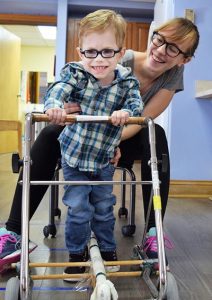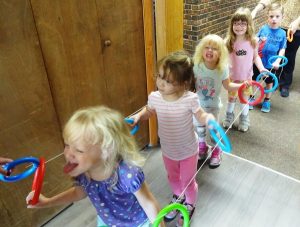Physical Disabilities
On the Table 2018 – “Getting my Wheel in the Door”
 Getting my Wheel in the Door
Getting my Wheel in the Door
Being a person with a physical disability, I know the struggles the disabled community faces when it comes to fully-participating in society. While our communities are more accessible than in the past, physical barriers still remain. It makes me wonder: what obstacles exist in our communities that our able-bodied friends do not encounter? If we, individuals with disabilities or those that use assistive devices, cannot “get in the door”, we cannot fully participate.
On the Table Conversation
This year, I led the Center for Independence staff in a discussion for On the Table. The theme of our conversation was about accessibility within our communities. I asked my co-worker’s thought-provoking questions such as: What barriers exist in our communities for individuals that use assistive devices? How are we as a society spreading awareness to able-bodied individuals regarding these restrictions? And lastly, how can we resolve the issues surrounding accessibility so all community members have equal access?
Americans with Disabilities Act (ADA)
“Legislation passed in 1990 that prohibits discrimination against people with disabilities. Under this Act, discrimination against a disabled person is illegal in employment, transportation, public accommodations, communications and government activities.”
With the passing of ADA in 1990, guidelines were set that required accessibility for anyone who uses any kind of assistive device. Doorways, aisles, and hallways need to be of a certain width for patrons who use mobility devices. Restaurants should have tables that are high enough for a wheelchair to fit under, and so on. But often, just because there is a sign saying an establishment is accessible, it does not necessarily guarantee it is the case.
If a person using a mobility device has to use a back entrance which is primarily used to take out the trash, it most definitely should not be considered accessible. If someone is physically unable to open a door, and there is not a push button available, this makes them physically dependent upon someone else to open it for them. As my friend and fellow social worker, Kathleen Downes, MSW so eloquently articulated: “Accessibility is about addressing architectural and physical barriers. Inclusion is about having welcoming attitudes to match. One is meaningless without the other. Inclusion and accessibility rely on one another.”
Breaking Barriers to Accessibility
You may not personally use an assistive device to access the community, but you most likely know someone who does. A mother pushing her infant in a stroller, an elderly person who relies on their walker, or perhaps a friend with a disability who uses a power wheelchair. We can all benefit from reducing or eliminating barriers within our communities to create a more inclusive environment. My mission, which emerged following the “On the Table” discussion this year, is to spread awareness of these accessibility barriers and work to eliminate or reduce them. Let’s work together to open doors for all!
Please feel free to continue the conversation and share your comments, thoughts or personal experiences related to accessibility.
Link to Facebook
— Ani Hunt, MSW, LSW
Ani Hunt is a licensed social worker who works with children with Cerebral Palsy who attend the Center for Independence, as well as their siblings and parents.
The Center Celebrates 20 Years!
Dear friends of the Center,
This year marks the Center’s 20th anniversary! We’ve grown from serving six children out of a local church to over 250 children per year at four locations throughout the Chicagoland area! What an amazing adventure, filled with so many wonderful people and beautiful moments.
In 1998, our original Board of Directors made a pledge that the Center would never turn a child away due to lack of insurance or inability to pay. Generous donors like you have allowed us to keep that commitment! Over the past 20 years the Center has served over 650 children and young adults with physical disabilities and given nearly $11million in charitable services. The Center has been a safety-net for children who are often turned away.
The Center is grateful to the many people who have helped our program grow and flourish: our Board of Directors; generous donors who support our program; talented professional staff who help children achieve their highest level of independence; and finally, parents who entrust us with their children.
Learning that your baby has cerebral palsy can be incredibly devastating for young parents and often results in many stressful unanswered questions: “Will my baby be okay?” “Will my baby grow up healthy and included?” “What does the future look like for my child?” The past 20 years have proven that despite challenges, the future is bright!
Families raising children with physical disabilities should dream big! Kids with cerebral palsy are happy, engaged, curious, and full of joy – just like their able-bodied peers. We have celebrated alongside families as their child achieved milestones including high school graduations, transitioning to college, entering the workforce, and living in the community independently. Given the opportunity, children with physical disabilities can do anything that they set their mind to – we witness that each and every day at the Center!
Thank you for your support over the past 20 years – your kindness has allowed us to help families believe in endless possibilities. We look forward to sharing many success stories of independence for years to come!
— Patricia Herbst, Executive Director
When is the Critical Time for Children with CP?
 Have you considered that there is a critical time for therapy for children with cerebral palsy (CP)?
Have you considered that there is a critical time for therapy for children with cerebral palsy (CP)?
From the ages of about zero to three, and again in puberty, children’s bodies and brains grow quickly. Intense therapy is important during those both of those times.
A Few Reasons Why:
It’s normal for bones to grow faster than muscles during growth spurts. This is where growing pains come from! In kids who don’t have CP, their muscles will eventually catch up in length. Spasticity makes this much harder for kids who do have CP, and those muscles get tighter and tighter during rapid growth. It’s so important to keep muscles as flexible as possible, because it’s really hard to fix once they get tight.
When kids grow bigger, their bodies get longer and heavier. Bigger bodies are harder to move and things that used to be easy become harder. Skills have to be practiced regularly, otherwise they might be lost.
Kids brains are growing rapidly during the ages of zero to three and again in puberty. This is the best time to practice good movement patterns! The brain is ready to learn and will remember things that are practiced in these times best. This is the aim of Conductive Education, which is founded on the premise of neural plasticity.
Critical Times Can Be Easily Missed
If a child with CP isn’t diagnosed soon enough, they might not start therapy early enough. If the child gets discharged from therapy when they are doing well right before puberty hits, they might not get therapy when they need it the most.
Karen Pape discusses these concepts in her book, The Boy Who Could Run But Not Walk: Understanding Neuroplasticity in the Child’s Brain:
“Diagnosis-specific treatment should be available during the important first four years of exuberant body and brain growth. There is no logical reason to wait. This is the time when there is the best possible chance for normalizing function.” 209
“Convince a teenager that the intensive, purposeful practice is worth it and he will improve, usually by one or two levels of function. It is a golden opportunity. This period, then, is a prime opportunity to work around established maladaptive habits.” 243
Share Your Thoughts on This Topic
Here are some questions to get the discussion going:
- Did you know about these critical times for therapy?
- What do you think can get in the way of getting therapy during these windows?
- What changes have you seen in your own child during these phases?
- How can we at the Center help support your goals for your child during these times?
Find us on our Facebook page to share you thoughts.

